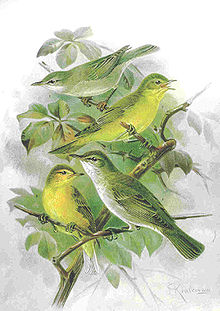
The typical warblers are small birds belonging to the genus Sylvia in the "Old World warbler" family Sylviidae.

The Iberian chiffchaff is a species of leaf warbler endemic to Portugal, Spain and North Africa, west of a line stretching roughly from the western Pyrenees via the mountains of central Spain to the Atlantic.

The yellow-browed warbler is a leaf warbler which breeds in the east Palearctic. This warbler is strongly migratory and winters mainly in tropical South Asia and South-east Asia, but also in small numbers in western Europe. Like the rest of Phylloscopidae, it was formerly included in the Old World warbler assemblage.

Hume's leaf warbler or Hume's warbler is a small leaf warbler which breeds in the mountains of inner Asia. This warbler is migratory and winters mainly in India.
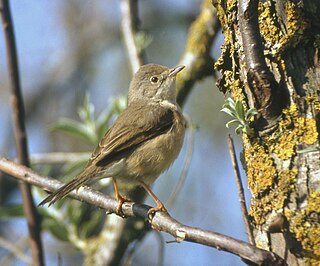
The western subalpine warbler is a small typical warbler which breeds in the southernmost areas of Europe and north-western Africa.

The Acrocephalus warblers are small, insectivorous passerine birds belonging to the genus Acrocephalus. Formerly in the paraphyletic Old World warbler assemblage, they are now separated as the namesake of the marsh and tree warbler family Acrocephalidae. They are sometimes called marsh warblers or reed warblers, but this invites confusion with marsh warbler and reed warbler proper, especially in North America, where it is common to use lower case for bird species.

Hippolais is a genus of tree warbler in the family Acrocephalidae. It is sometimes associated with the genus Iduna. The genus name Hippolais is from Ancient Greek hupolais, as misspelt by Linnaeus. It referred to a small bird mentioned by Aristotle and others and may be onomatopoeic or derived from hupo,"under", and laas, "stone".

The melodious warbler is an Old World warbler in the tree warbler genus Hippolais. It breeds in southwest Europe and northwest Africa. It is migratory, wintering in sub-Saharan Africa. This small passerine bird is a species found in open woodland with bushes. Three to five eggs are laid in a nest in a tree or a bush. This is a common bird in many parts of its wide range and the International Union for Conservation of Nature has rated its conservation status as being of "least concern".

The icterine warbler is an Old World warbler in the tree warbler genus Hippolais. It breeds in mainland Europe except the southwest, where it is replaced by its western counterpart, melodious warbler. It is migratory, wintering in sub-Saharan Africa.

The western olivaceous warbler, also known as isabelline warbler, is a "warbler", formerly placed in the Old World warblers when these were a paraphyletic wastebin taxon. It is now considered a member of the acrocephaline warblers, Acrocephalidae, in the tree warbler genus Iduna. It was formerly regarded as part of a wider "olivaceous warbler" species, but as a result of modern taxonomic developments, this species is now usually considered distinct from the eastern olivaceous warbler, Iduna pallida.
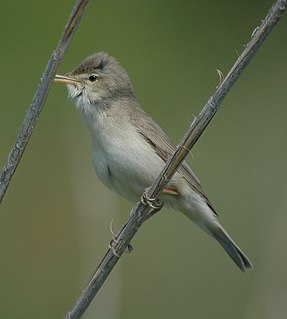
The eastern olivaceous warbler is a small passerine bird with drab plumage tones, that is native to the Old World. For the most part it breeds in the northern Afrotropics and winters in southeastern Europe, the Middle East and adjacent western Asia.

The booted warbler is an Old World warbler in the tree warbler group. It was formerly considered to be conspecific with Sykes's warbler, but the two are now usually both afforded species status. Booted warbler itself breeds from central Russia to western China, and migrates to winter in the Indian subcontinent as far south as Sri Lanka. Booted warbler has expanded its breeding range westward in recent decades and nests now as far west and north as Finland. It is a small passerine bird, found in open country with bushes and other tall vegetation. 3-4 eggs are laid in a nest in a bush or vegetation. Like most warblers they are insectivorous.

Sykes's warbler is an Old World warbler in the tree warbler family. It was formerly considered a subspecies of the booted warbler, but is now considered a full species. Its breeding range is from northeast Arabia to Turkestan, West China and Afghanistan. Like the booted warbler, many populations of the species migrate in winter to the Indian subcontinent as far south as Sri Lanka.
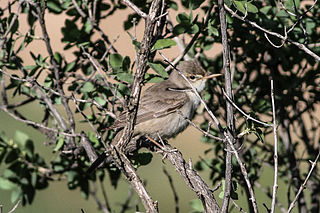
Upcher's warbler is an Old World warbler in the tree warbler genus Hippolais. It breeds in an area from Turkey south and east to Pakistan. It is migratory, wintering in eastern Africa, from Eritrea and Somalia south to Tanzania.
The eastern subalpine warbler is a small typical warbler which breeds in the southernmost areas of Europe. It was first described by the German naturalist Peter Simon Pallas in 1764 and given the binomial name Motacilla cantillans. The specific cantillans is Latin for "warbling" from canere, "to sing".
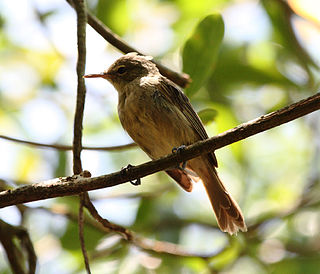
The Seychelles warbler, also known as Seychelles brush warbler, is a small songbird found on five granitic and corraline islands in the Seychelles. It is a greenish-brown bird with long legs and a long slender bill. It is primarily found in forested areas on the islands. The Seychelles warbler is a rarity in that it exhibits cooperative breeding, or alloparenting; which means that the monogamous pair is assisted by nonbreeding female helpers.

The Acrocephalidae are a family of oscine passerine birds, in the superfamily Sylvioidea.
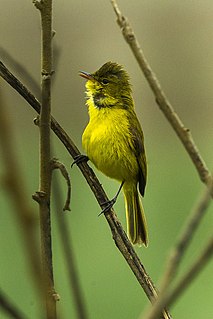
The African yellow warbler, Natal yellow warbler, dark-capped yellow warbler, or yellow flycatcher-warbler is a species of Acrocephalidae warblers; formerly, these were placed in the paraphyletic "Old World warblers".

Iduna is a genus of tree warbler in the family Acrocephalidae. Keyserling and Blasius gave no explanation of the genus name Iduna. It is sometimes lumped in the genus Hippolais, although in 2009 it was found to belong to the Iduna clade.
Colin Bradshaw is an English physician and ornithologist who was chairman of the British Birds Rarities Committee from 1997 to 2008. He was active in the BBRC for almost 20 years, both as a committee member and as chairman. He is a medical doctor by profession and travels extensively for birding, and among his other hobbies are guitar, cricket, and photography.
